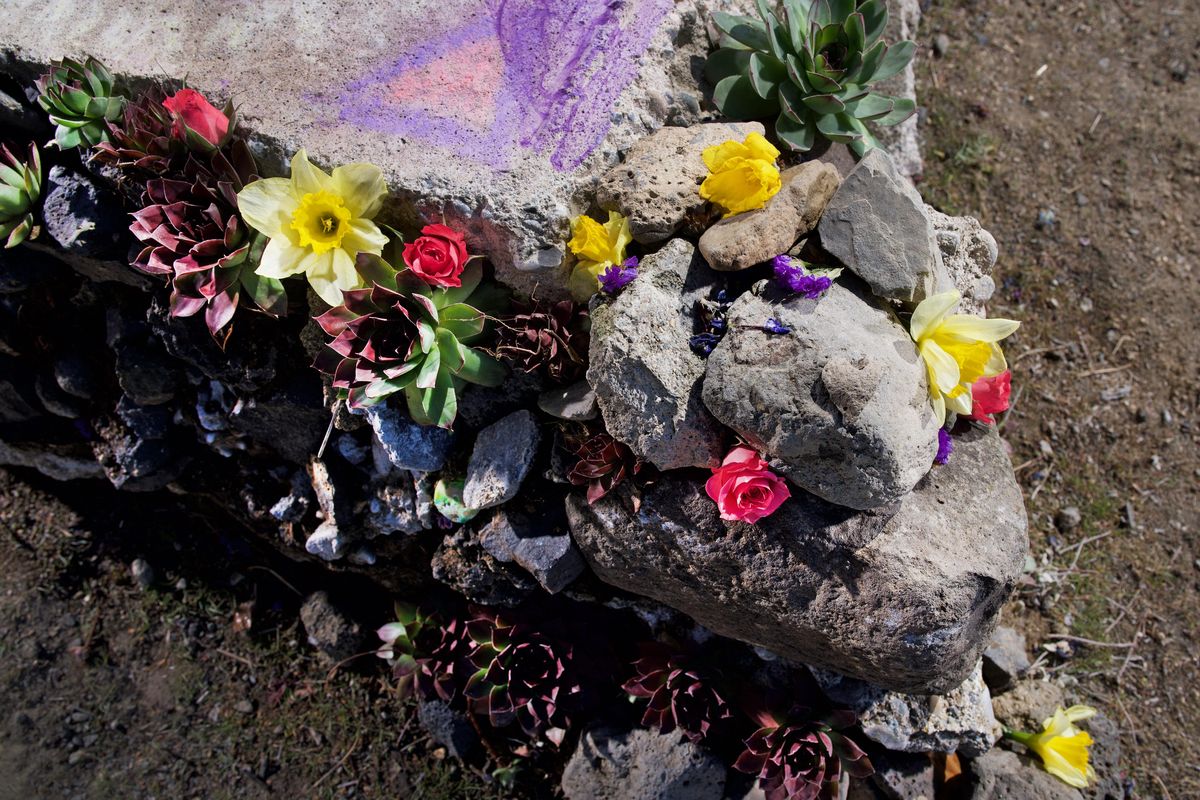Shawn Vestal: As supplies dried up, artists created a ‘hidden jewel’ on the bluff

In ordinary times, Ava Barany and Sarah Edwards use leftover flowers and natural materials to create works of art that lie in wait, in parks and public spaces, to delight anyone who might stumble upon them.
But the two artists, who call themselves The Botanical Alchemists, rely heavily on florists to give them unused flowers for their creations, and during the coronavirus shutdown, the supply of unused flowers has dried up.
So they turned to stone.

Over the past week, Edwards and Barany created a large snake and a spiral labyrinth out of rock and concrete debris on a small plateau overlooking the Latah Valley, just below Polly Judd Park at the western end of 14th Avenue. The sculptures involve hundreds of pounds of stone and concrete, and are sure to outlast many of their other works – remaining in place to surprise and engage passersby who have no idea what awaits them around the next bend in the trail.
“Even if you’re social distancing, you can still come be six feet apart in the labyrinth,” Barany said.
The pieces are large and arresting, and they invite you to interact – to walk the labyrinth or step on the sturdy snake, to add to them if you choose. They’re also a bit hidden, invisible from the park itself or the roundabout that dead-ends there. But if you walk west from the roundabout toward a small overlook, the pieces appear serendipitously below.
“It’s a hidden jewel,” said Claire Rudolf Murphy, who lives on the north side of the park.
Murphy had seen some of the flower work the two artists had installed around the park before. Then, last Friday, she and some of her neighbors were engaged in some social-distance socializing – standing outside, well apart from each other, chatting – when a neighbor asked, “Claire, have you seen the spiral?”
Before long, not only had she seen it, she’d walked it.
Edwards and Barany have been making art together for about a year and have attended festivals where they produced artworks out of found materials in the environment. In Spokane, they’ve frequently used flowers that were past their prime and donated by florists in town to make bright, arresting designs in parks and other public spaces.
“They had a whole lot of flowers that were just going into the trash,” Edwards said. “They gave me the stuff they were going to throw out. It can be a lot. Four buckets of roses – a lot.”
They’ve made several pieces in and around Polly Judd Park. For example, in February, they made a bird with an outline framed in sticks and limbs, fleshed out in brilliant color with flower petals. The idea, according to their mission statement, is to create ephemeral artworks that help people connect more deeply with themselves and with nature.
The Botanical Alchemists is also growing a business side, doing private works, as well. And it recently received a Spokane Arts Grant Award grant, with which they plan to host free workshops in which people can make art in nature themselves. They’re also seeking further sponsorships for their work, much of which can be viewed on their Instagram feed.
When The Botanical Alchemists lost the botanical fodder for their alchemy, it presented a challenge. Edwards had long had the idea of a spiral labyrinth in mind, akin to the spirals that artist Andy Goldsworthy creates out of natural materials. These flowerless days seemed like the perfect time.
Edwards and a friend put most of the spiral together last Wednesday. Walking it, you circle gradually toward the middle and then gradually outward again, without ever turning around.
As Edwards looked it over from a perch above, the notion of a snake with a flickering tongue occurred to her – a sculpture that could be made from the large, flat pieces of broken concrete that had been dumped there over the years.
They enlisted a group of friends to help with the heavy work: Mokeph Wildflower, Jeremiah Hebden, Patrick Sandstrom, Jake Headlee, Colleen Sullivan and River Hyla. They also cleaned up a lot of litter – “buckets and buckets of broken glass.”
On Thursday, they were accentuating the pieces with flower petals, white stone, feathers and other materials, lending some color to the stone shapes. At the center of the labyrinth was a collection of stones and shells, flowers and glass pieces, and irises.
Murphy stopped by as they were working.
“I just couldn’t be more delighted,” she said. “It made me happy, and right now, that’s in a little bit of short supply.”